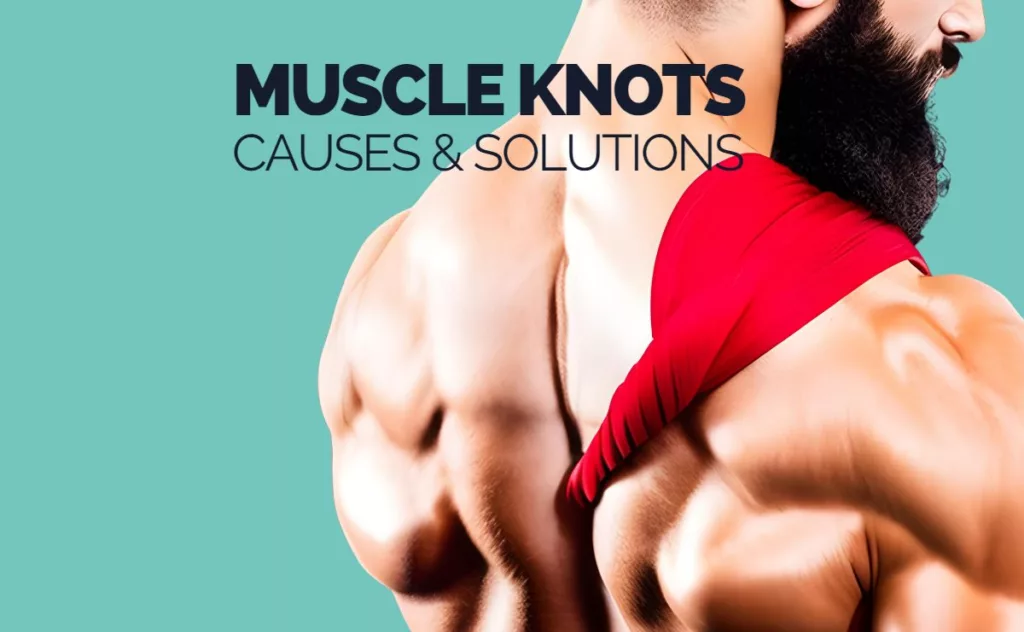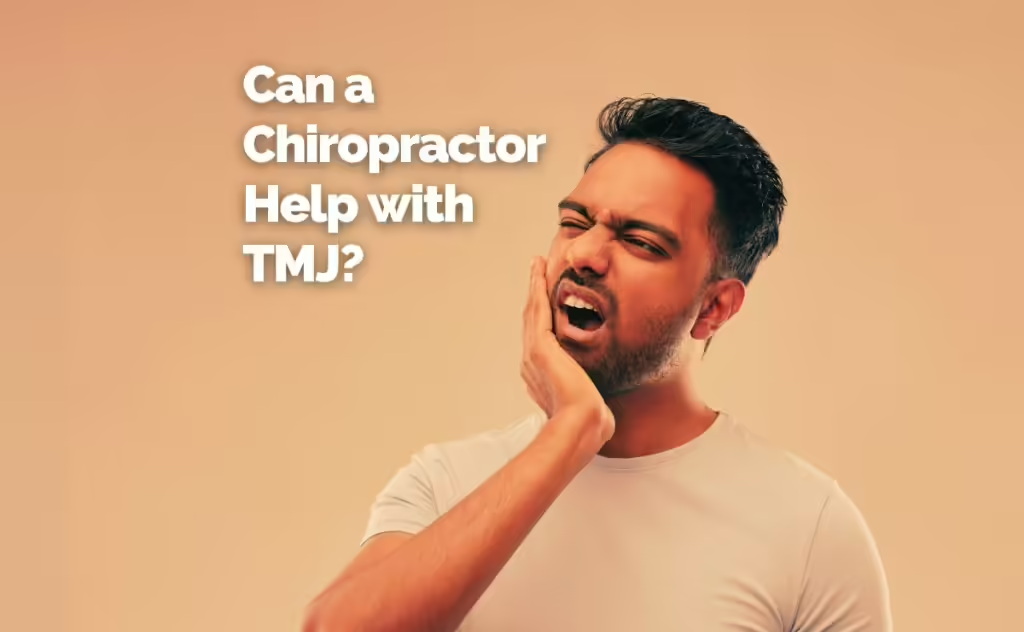Muscle Knots: What Are They?
It’s really common for you to feel muscle knots in your neck and shoulders when you are sitting for long periods of time. Many of our patients who come to us experience pain in between their shoulder blades. When they reach back to feel what’s wrong, they can feel the dense area of tight muscles. These are knots.
Knots in your muscles are also known as trigger points and, if you press on one, it is usually tender. If you press hard enough you will also feel some of the pain radiate from the area.
You might be familiar with this sensation.
What Is Happening When My Muscles Tense Up?
A knot in your shoulder muscles is actually a small bundle of muscle fibers. Normal muscle fibers work by making power and producing movement when collagen filaments called sarcomeres slide past each other. When you contract your muscle, the fibers telescope together.
A normal, unstressed muscle at rest has these Sarcomere fibers (called Actin and Myosin) extended in a somewhat lengthened position. The muscle tissue telescope outward. When you contract your muscle, these fibers slide together. At rest, a muscle will have imperceptible action that neurologists and chiropractors can measure with special equipment. This is a muscle’s resting tone. As long as your muscle isn’t actively contracting to hold you up, stabilize you, or to pick something up, then there is minimal activity in the muscle. There is a low-level activity of muscle tone.
When your muscle contracts, there is a greater amount of activity. Muscle tone goes up throughout the whole muscle. Ultimately, the heavier the work, the more tone is involved as muscle bundles are recruited more and more.
Trigger Points
However, a knot or trigger point is where something has gone wrong. A knot is a bundle of muscle fibers that are continually contracting by themselves at a tiny spot on the muscle. A tiny spasm. This knot is surrounded by muscle fibers at rest.
There is no physical pathology involved in a knotty trigger point. If you were to take a biopsy sample of this muscle tissue, you would see that there are normal muscle fibers in there. (They’re not actually tied into a knot.) The muscle fibers in the knot would look the same as the adjacent rested muscle fibers. This means that a knot is purely physiological. Your nerves are providing a reflex to feed instructions to the muscles to keep a certain spot contracted. There are reflex loops going back and forth that may be forcing your body to hold this contraction, too.
Cinderella Fibers
Some researchers have been investigating neck muscle knots, and the theory they came up with is what they call the “Cinderella Fibers Theory.”
Cinderella fibers are the tiny bundles of muscle fibers doing all the work for the whole big muscle.
To look into the cause of muscle knots, researchers have put people through certain tasks to measure muscle activities. They discovered that when you are working at a desk doing repetitive small movements with your fingers, like typing and using a mouse repetitively, your shoulders and neck have to respond with micro-movements of the muscles.
Releasing The Tension
It turns out, the best way to relieve the pain and reflexive loop of a muscle knot is to actually make the whole aching muscle work More. You can relieve the pain and tension from muscle knot Cinderella fibers by lifting a heavy weight to get the whole muscle contracted. For example, if you have trigger points developing in your trapezius muscle between your neck and shoulder, and this was caused by working all day at your computer, then you should be able to go home and pick up some weights to work out the whole muscle. This will relieve the pain and relax the tight fibers. Give it a try with some gentle weight loads at first, then progressively try harder weights.
Or give my kickball exercise for the neck a try:
Here are some other things that can make your muscle knots worse:
- Bulging discs in your neck
- Herniated discs in your neck
- An inflammatory diet
- Scar tissue in the muscles and other soft tissue in your neck and upper back
- Poor working posture
- Upper cross syndrome, which is a posture characterized by tight chest muscles, an anterior head posture, and weak but knotty back muscles
- Stress. A flight-or-fight response can trigger a reflex to tighten back muscles. Also, the stress hormone Cortisol can perpetuate tight and tender fibers in your muscles
- Degenerative Disc Disease. Also known as Spondylosis or Degenerative Joint Disease
What You Can Do At Home
Everyone has their own preferred ways of treating knots and sore muscles. Usually a great place to start is with home remedies. Home remedies include:
- Posture awareness.
- Ergonomics.
- Foam rolling. You can roll out the tight knots directly with a foam roller, or you can use the foam roller to address tight vertebrae in your upper back. This will help you with posture, too.
- Lacrosse ball. It’s very popular to roll out muscle knots with a hard ball. This allows you to use the technique of ischemic press at home. Be careful, it’s tender!
- Home exercises. As I said above, if you have tight fibers, getting the whole tight muscle to contract and become conditioned is a counter intuitive way to provide relief, and prevent future problems.
- Anti-inflammatory diet. An anti-inflammatory diet is beyond the scope of this article, but if you were able to make some simple dietary changes toward natural, unprocessed foods, this will help reduce the pain you feel in your body.
- Stress-management. Pick your method. Stress is a big cause of reactive tightness in your shoulder muscles. Again, exercise is an important part of balancing out life’s stresses.
Sometimes You Need A Helping Hand: Professional Help
If you need professional help to break through barriers to chronically tight muscles, here are some things that you should try. (And these are some of the therapies we have at Rincon Chiropractic Acupuncture & Massage):
- Chiropractic care
- Acupuncture
- Cupping
- Hot stone massage
- Deep tissue massage
- Corrective exercises
Chiropractic Care Is Effective For Muscle Knots
Chiropractic care uses spinal adjustments (spinal manipulative therapy) as a modality of care. After we identify tight and restricted areas of your back that may be causing problems, an adjustment will restore normal mobility immediately. This fast stretch reflex that you enjoy provides a reflex that rests the tone of the muscle spindles in your back. It relaxes you.
The improved mobility also provides mechanical delivery of fresh nutrients to ligaments and discs that don’t otherwise have a great blood supply. The discs in your back thrive through movement that allows them to soak up nutrients like a sponge. Likewise, a great adjustment will release pain-relieving local endorphins. The feeling you get afterward is one of better, pain-free posture. Like the stiffness has been lifted away. Less pressure.
Acupuncture & Massage Can Also Be Valuable Tools
Acupuncture allows you to be in a balance, relaxed state. Reflexes arising from the receptors in your skin allow you to let down your guard, and enjoy less body aches. Acupuncture has been shown to trigger responses in the brain for pain relief, and it releases neurotransmitters and neuromodulating hormones through the nervous system.
Various massage therapy techniques are an obvious way to get direct help with trigger points. Trigger points respond to directly applied pressure and stretches. Massages can get right to the knot, and relax them with skilled hands. Massage also relaxes your nerve pathways for pain and body signals. Our office, along with providing excellence in chiropractic care and acupuncture, has a variety of licensed massage therapists available.
So, if you are looking for professional guidance for trigger point and muscle knot pain, we can help.
Ryan Todd Lloyd, DC
Marshall Luck, DC


